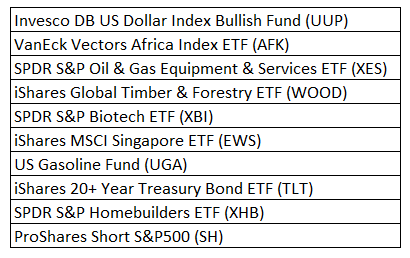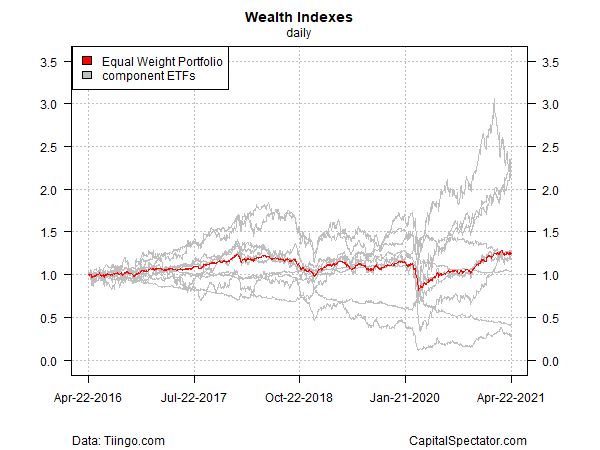Capturing Average Returns With Asset Allocation, Part III
<< Read More: Capturing Average Returns With Asset Allocation, Part II
<< Read More: Asset Allocation Is A Strategy For Capturing Average Results - Part I
In recent posts I looked at the power of asset allocation to capture average returns (or slightly better) and manage risk in portfolio design. Several tests show that this tool is robust for a variety of standard portfolio mixes. Let’s take the analysis up a notch by creating an ill-advised portfolio as a stress test.
We’ve seen previously that equally weighting assets for reasonably designed strategies reliably captures average performance and risk. Does the result hold up if build a portfolio that’s intentionally reckless? If average results can survive this gauntlet, we’ll have stronger support for thinking that diversifying over assets is more or less foolproof.
Enter the Motley 10 – a mostly random selection of ETFs that collectively add up to a thoughtless bag of assets for portfolio design.
The above list is no one’s idea of informed investment design, but it does serve the purpose of testing how equally weighting the mix fares under relatively extreme circumstances. Indeed, the five-year window we’re looking at has seen extreme moves in the funds listed.
Despite a mix of strong winners and deep losses in a few dogs, the average portfolio earned a modest profit. Investing a dollar in an equally weighted mix of the ten funds (and rebalancing to equal weights every Dec. 31) posted a modest 24% cumulative gain through yesterday’s close (Apr. 22). That hardly impressive, considering what you could have earned with a reasonably diversified portfolio. But considering the lack of informed fund choices involved in the test, the performance is surprisingly positive. Or maybe it’s not so surprising after all.
Expected or not, it’s somewhat reassuring to know that equal weighting can save your bacon even when you do stupid things with asset allocation. Indeed, most of the fund holdings in this example suffered significant losses or delivered middling performance. Three posted strong above-average results, albeit with high volatility.
Risk for the Motley 10 was also middling relative to the field of holdings. For example, the portfolio’s deepest drawdown was relatively mild vs. the steepest peak-to-trough slides for several of the ETFs.
This simple test is a powerful reminder that even a naïve strategy of diversifying across assets is highly likely to sidestep some awful investment choices. Choosing weights is tricky, of course, and deserves careful thought. But as a baseline, and a generally robust solution, equal weight is usually a prudent choice.
Fortunately, there’s no reason to make intentionally poor asset allocation decisions when picking a set of funds. What happens when we apply a bit of common sense to the mix and look for opportunities to juice the average a bit? We’ll explore some of the possibilities in an upcoming installment of this series.
Disclosures: None.





